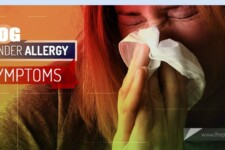Dog Saliva Allergy: What You Need To Know (Key Facts)
Nothing is more affectionate than leaning in for a slobbery kiss from our dogs.
However, many of us do not think about the implications of these gestures. After all, how can something that brings so much joy in our lives cause misery?
While fondness between dogs and humans is common, pet owners have inadequate knowledge surrounding dog saliva and its effects on your health.
There is sufficient evidence that attributes dog saliva allergy to humans.
If you`re one of the many people who religiously groom their dogs but still have an allergy to them, you might be suffering from an allergy to their saliva.
In this article guide, we will highlight why dog saliva is an allergen, why some people are allergic to dog saliva, signs and symptoms of the saliva allergy, and potential remedies.

Why Dog Saliva is An Allergen
Dog saliva is the primary cause of dog allergies.
A study published in Oral Biology indicates that dog saliva has at least 12 known allergy-causing bands.
Specifically, with the presence of Can f 1, the most common dog allergen, you`re bound to have an allergy when you come into contact with the dogs’ saliva.
More to this, the study goes further to indicate that there can be an oral transmission of the allergy-causing bands.
Thus, it`s possible for the allergens to get transmitted through dog kisses, and you should therefore never let your guard down.
- Transmission of the allergens goes beyond actual contact with the saliva, but can also be transmitted through the air.
- For instance, if your dog licks its fur, the allergens are deposited on its coat. With time the coat dries alongside the allergens, causing them to get light and airborne.
Therefore, having a this type of allergy does not necessarily mean coming into direct and constant exposure with the dog’s saliva.
Please note the information in this article is for general knowledge only, and is not intended as medical advice. If you experience allergy issues then please talk to your regular doctor for a professional medical opinion.
Symptoms Of Dog Saliva Allergies
A dog is man`s best friend-that is unless the man is allergic to his dog.
The saliva allergy range from mild to severe and may manifest themselves immediately or several days after exposure, depending on an individual`s sensitivity.
Let`s have a look at the common symptoms of this allergy.
1. Rhinitis
Rhinitis, commonly referred to as the nasal congestion or stuffy nose is a major symptom of saliva allergy.
In most cases, the manifestation of a stuffy nose is through a scratchy throat, post-nasal drip, and a runny nose.
A scratchy throat may lead to temporary voice loss.
2. Asthma and Hives
All symptoms experienced from allergy to dog saliva are undoubtedly bothersome, but asthma and hive present an uncomfortable experience.
With asthma, the bronchial tube constricts and gets inflamed causing breathing difficulties and shortness of breath.
On the other hand, hives cause patches of pink welts that are often raised and itchy. The pinky welts can appear all over the body and are accompanied by a rash bump.
3. Itchy Eyes, Coughing, and Sneezing
Other common telltale signs of this saliva allergy include dry and red, itchy watery eyes. In most cases, the itchy eyes are accompanied by persistent coughing and sneezing.
To lessen the effects of the above symptoms, you should avoid touching your eyes or face, after having contact with your dog.
Other signs and symptoms that you should always look out for include:
- Redness of the skin after being licked by a dog.
- Eczema (painful inflammation of the skin).
- Frequent awakening.
- Frequent rubbing of the nose.
- Wheezing.
- Trouble sleeping.
- Chest tightness.
Diagnosis Of Allergic Reactions To Dog Saliva
There are different ways to determine whether you are allergic to dog saliva.
In most cases, diagnosis is done through:
- A skin test.
- Allergy blood test.
Details on Skin Tests
The skin test is the most popular dog allergy diagnosis test.
It`s preferred by many because it`s safe, convenient, easy and does not involve any pain.
The initial skin test in the skin prick test, which involves placing drops of Can f 1 on a suspected forearm. The skin is then light pricked with a special needle for immediate absorption.
If the skin swells or develops redness within 10-20 minutes, the test is considered positive. Besides, the swelling must be greater than 3mm.
The intradermal skin test, on the other hand, entails injecting C f 1 into the epidermis and then measuring any swelling.
Despite its convenience, the skin tests are inconclusive and not the best way to determine your allergy to dog drool.
Nonetheless, they will provide you with a hint on your allergy level.
Details on Allergy Blood Tests
Allergy blood tests, also known as radioallergosorbent test involves mixing your blood sample with Can f 1 allergen.
- The test is performed in a lab, and any reaction is assessed by the physician to determine whether you`re allergic or not.
While the tests are vital in determining the cause and possible treatment of the allergy, such tests are not always definitive.
Nonetheless, if you`re certain you`re allergic, testing is still a good idea, and it will help your doctor prescribe an adequate treatment.
Treatment and Management of the Allergy
Certain dog breeds are known to cause this allergy more than others.
Ideally, the best dog breed to adopt is hypoallergenic breeds since they don`t drool much, and also choose one that is easily trained.
See our list of best hypoallergenic family dogs
The next step is that you should train your dog to keep its mouth and tongue from you.
Train your dog to refrain from licking, play biting and sharing his toys with you.
There`re plenty of ways to express affection to your dog beside the slobbery kisses and licking.
Make a habit of wearing hand gloves when playing with your pet. Though it seems awkward, it will allow you to handle your dog without the worry of having an allergic reaction.
Just like other dog allergies, you can manage this allergy with medication. Consult your doctor to discuss allergy shots (immunotherapy) to reduce the risk of an allergy.
Conclusion
Understanding the risks that come with dog saliva allergy is crucial, especially if you have a dog and are allergic to dog saliva.
Some of the risks include the development of asthma, running nose, bronchitis, eczema among a gamut of other signs and symptoms.
However, if you never want to experience this allergy, the surest solution is getting rid of your dog.
Of course, with all the joy that our dogs bring to our lives, no one is willing to give away their dog.
Therefore, you should learn how to manage this particular allergy, for instance, wearing gloves when handling your pooch, getting allergy vaccination, etc.
Ensure you see your family doctor when attempting to find if you have an allergy, as self-diagnosis can frequently be wrong. It is important to get a professional medical opinion.



